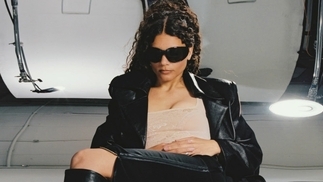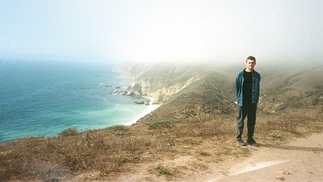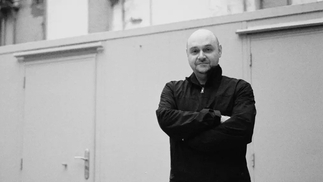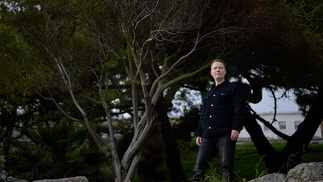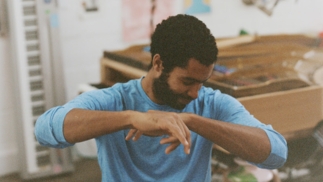DJ MAG MEETS FACTORY FLOOR
Holding court with one of the UK’s most innovative electronic duos...

“Everything around you is so cluttered. If you go online and look at social media, it’s this big bombardment of stuff. I really wanted to de-clutter everything.”
A jet-lagged Nik Void — guitarist, singer, and now chief synth modulator — is trying to explain over Skype the minimalism at the core of Factory Floor’s new album. It’s only their second; despite having been around in various incarnations for over seven years, the band have never been the most prolific when it comes to traditional releases.
Instead, they’re thoroughly modern in their output, as likely to devote their energies to perfecting their seething live show, or collaborating with gallery spaces, as they are to pushing themselves into making an album.
Since 2013’s triumphant, self-titled debut they’ve toured the globe (including a notably wild show at the Tate, where their militant machine-funk drove some of the audience into such a frenzy that they decided to strip naked), and spent time as artists in residence at such high-brow locations as the Barbican and Stromboli.
Alongside this, Void has been moonlighting with synth duo Chris & Cosey (formerly of '80s industrial noiseniks Throbbing Gristle), drummer Gabe Gurnsey has been recording solo techno bangers for the likes of Phantasy Sound, and the third member, Dominic Butler, has departed to pursue his own projects.
With so much going on, it’s perhaps understandable that a new album has taken so long — particularly considering the sheer effort they put into recording when they finally do decide to.
“When we started Factory Floor, we had our own rules and our own pace of doing things. For this album, we decided to record everything live,” Void reveals. “It may not sound live, but it is — it’s live and spontaneous. That can be quite heavy going. You’re working on one track for four or five hours, still playing the same loop. Then we’ll go back a couple of weeks later and dissect it, take things out and figure out if bits are needed.
To do that, we have to find a place to work which isn’t a studio. It needs to be an area that we can leave our set-up in and come back to it, and not be trapped into doing something in a block of time. We’re conscious of things sounding too similar when you work on the kind of kit we do.”
“It does get intense,” Gabe Gurnsey adds. “The space is important. We had to leave our old place in Seven Sisters a couple of years back [where debut album 'Factory Floor' was recorded]. This time we set up in an old silk factory up north.
All the tracks are made of takes of us playing in that space. We were using live takes so we didn’t have to edit the tracks too much, we wanted that spontaneous feel to them. We set up a full PA this time, so we were playing through quite an intense loud PA as we were writing. We wanted that feel of how we get our sound in clubs or in festivals, so we were kind of going in that direction for this record.”
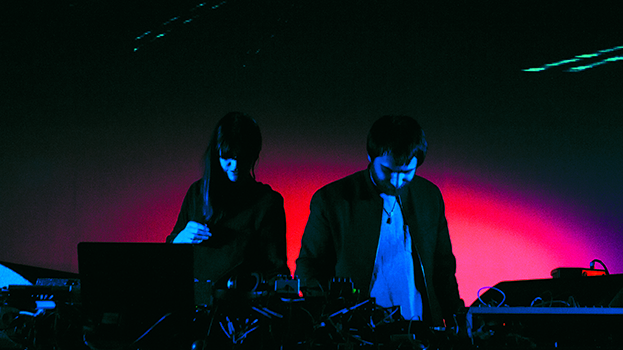
SQUALLS
The end result, '2525', is a triumph. Eight tracks of paranoid, bunker techno, the album is tense with contradictions; spacious grooves pulse with claustrophobia, the rhythms a rigid, uptight funk at odds with the synths and warping vocals which swoop in and out in loose, ragged squalls.
Its closest relative is the raw analogue house and techno pumping out of late '80s America, albeit stained with a moody, British sense of darkness. Tracks such as 'Dial Me In' are stripped down to nothing but stark essentials; an acid line, a kick-drum, stabbing percussion, and Nik Void’s weird, dislocated vocal, her heavily processed tones sounding like an algorithm striving to convey the sleaze of Chicago house’s finest. Void talks of her vocal manipulation as a very conscious alienation technique.
“What was exciting me about vocals wasn’t so much a melody as how I dissected that vocal. I kept on getting further and further into that in the creation of this record. All the vocals on this record are mine but they sound like different people — almost. Each track had a different personality, I love pitching my voice down.
As I’m getting older I like to depersonalise myself from the music, so the music speaks for itself. I don’t like the idea of being a pop star. I think what Gabe and I enjoy is trying to explore our instruments more and push them to an extreme — that’s what we did on this record, and that’s what I did with the vocals.”
According to Gurnsey, then, this love of pushing their kit to extremes had a distinct impact on writing the album — particularly their decision to turn everything up to PA volume levels. “If we write stuff through some small monitors and then take it to a festival, it translates differently — so we wanted the kind of power of the PA to be at the forefront of writing, so it translates through. When we take our set out now, that’s how we’ve written it on the record.
It’s never gonna sound identical, but you get a better feel for how it’s going to sound out. It made us not fill the soundscape out too much, as it was loud enough already. Maybe that’s why the record has a more minimal feel to it.”
“From an observer's point of view,” Nik interjects “it must have been quite funny to see us recording. Our kit goes directly into the computer, and we haven’t got our voices mic'd up. We’re set up opposite each other in the room, so I’d be shouting 'CHANGE! CHANGE NOW!' over the noise. That was as technical as we got.”
FACTORY
Much has been made of the link between techno music and industrial soundscapes, and it seems fair to assume that recording an album in a disused factory might have had some impact on the recording. It's something that Void acknowledges. “It was really dark; the windows were all boarded up. It wasn’t a studio as such, we just set up in the middle of the floor. You’d walk into the building and feel the thickness of the walls.
“The fact that the windows were all boarded up made it cavernous, and we could push the volume so much without disturbing this really nice, natural world that was outside. It was in the middle of nowhere, and that was quite different to recording in North London, where you were aware that there were other people around you in that warehouse space.
There were people coming and going there, and it does make you aware, it makes you work slightly differently when you’re conscious that there’s other people walking around, they might have thoughts about what you do, but this place, it was totally away from anywhere else, it was almost like the building was shielding us from the outside world.
“It was pretty gritty as well, we don’t like going to spaces that are too clean, it makes you slightly polite in the way you attempt to make music.”
“I don’t think we could do it in a normal studio,” Gabe adds “We just don’t work like that, we like to get in there, make a mess, and have all our kit lying around. It definitely gives us a better focus. This record has a lot more focus on it than the last record. It seems a lot more consistent.”
Some of that focus can be attributed to the departure of Butler. An apparently amicable split, the reduction of three to two has created additional room for the Factory Floor sound to unfurl itself.
“Yeah, in terms of sonic space, me and Nik had a lot more space. The jump of Nik from guitar to synth really inspired me. It just bought up a whole new kind of sonic palette, for want of a better term. It was really fresh for me, and it was a good next step for Factory Floor having Nik do that side of it — we could explore new stuff, me and Nik were really working on things gelling.
Nik was bringing in a lot of modular drum stuff, for me that’s exciting to play on as a drummer — it was just a lot of nice sound communication, and I think we get that onstage now. It’s between me and Nik, it’s not between three people.”
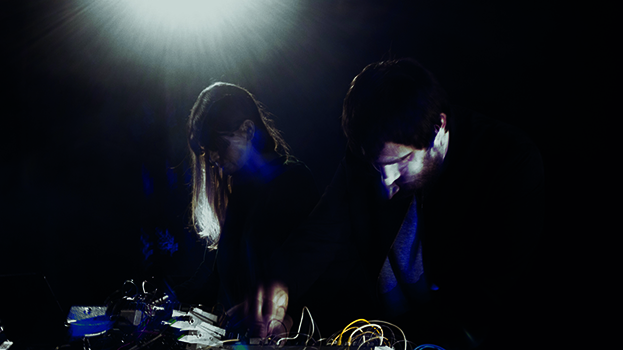
VISCERAL
Their live show has always been a central part of the Factory Floor experience. Unlike so many of their electronic contemporaries, they continue to perform live in the traditional sense, with almost everything left open to the possibility of spiralling out of control on the night. It’s a visceral experience, and one that continues to make their performances almost ritualistic in nature, maelstroms of man and machine colluding in barely-working harmony.
Alternatively, you could enjoy them for what they most definitely are; banging, mesmeric raves that hark back to the golden age of techno. Crucially, they’re all about creating energy with trance-like repetition, something even more possible now Gurnsey has abandoned live drums for the tempo-locked grooves of drum machines.
“We still get that kind of extreme response from the audience, we can still achieve the same kind of intensity and hypnotic feel in the room when we play,” he tells DJ Mag. “I don’t know how it comes about, but it just does.
I think we’re almost able to get the same energy by using electronic gear as we could with using the live kit. I find that really fun to do, trying to push the drum machine as far as it can go to emulate that kind of live energy. We had a show in New York the other day where we’d lost all our gear, so I was using just one drum machine I‘d had to borrow off someone. I ended up kind of pushing it to death, but it was really fun to do.”
Nik agrees: “I feel it’s how we approach our instruments. I personally don’t read manuals, I find my own way around working stuff, and because of that it sounds like it’s going to fall apart at any moment when we play live.
That intensity of pushing machines to the max, overdriving them — the drum machine that Gabe was using, I think it was kind of surrendering! Like, 'Get off me, your killing me!' Hahaha... And I think people get really excited by watching something that sounds like it’s going to fall apart at any moment, watching machines being played by people, not just something that’s pre-recorded or programmed so much.”
If you were feeling like getting clever with it, you could consider these chaotic performances — this tension between human performers torturing reluctantly acquiescent machines — as an interesting metaphor for our unsteady relationship with the technology that surrounds our modern lives. This isn't something the band will be drawn into claiming themselves, though.
They’ve no interest in trying to put out any obvious ‘messages’, and shy away from attempts to rigidly define their music. Even when asked on the origins of the cryptic-sounding new album title '2525', it turns out there is an almost comically prosaic reason behind the name.
“The title is the catalogue number of the record,” Nik laughs. “We kind of don’t want to bring in a narrative to the record. When we play, we like people to have their own thoughts about the record, we like to give them space to think. We don’t like to write a title of a record and then people think, ‘Ah, that record's about that’, we want some distance — we saw the catalogue number and thought, ‘Oh that sounds good, we’ll use it’.”
“It works, in that to make the album we just went in, plugged in, played and recorded,” Gabe concludes. “That’s just what it is, and the title is just the catalogue number, you know, we leave the rest for other people to think about. It’s all open to interpretation.”
Words: Ian McQuaid
